Transferring.
Some care recipients will need assistance with transferring or moving from one place to another. This may include getting into a sitting or standing position and moving from the bed to a chair and back. It is important that this is done with the least amount of stress to the care recipient and to you. Care recipients will have confidence in you when you know your strength and your capabilities and stay within those limits. Care recipients should be allowed to do as much as possible for themselves. As they become stronger, the amount of help you provide will decrease; but, stay with them, give directions, and help where needed. Be alert for problems such as weakness or dizzy spells, which could cause them to fall. Older people often get dizzy when changing positions, so do the procedures slowly, allowing them time to adjust to the position changes. A transfer belt, or gait belt, can help with the work of transferring, especially with heavier care recipients. A transfer belt is made out of canvas or leather and is fastened around their waist. It should be wide enough and heavy enough for the care recipient you are using it on. The belt is used by you to grasp with your hands to assist with moving or transferring. Remember that you and the care recipient must use good body mechanics when doing these procedures to make sure they are done safely. Have a good base of support, keep the back straight, and bend the knees.
Use of assistive devices and different transfer techniques in transferring clients:
1. Chair
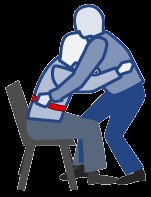
2. Gait belt
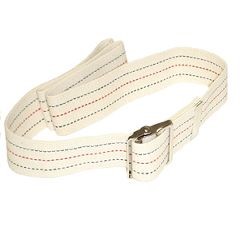
3. Mechanical lifters (Hoyer)
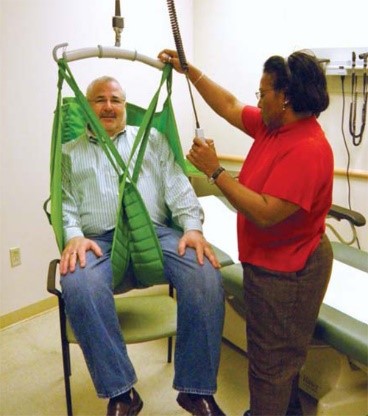
4. Slide board
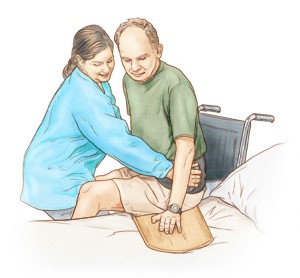
5. Lift sheet (draw sheet).
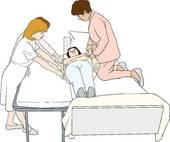
7. Wheelchair
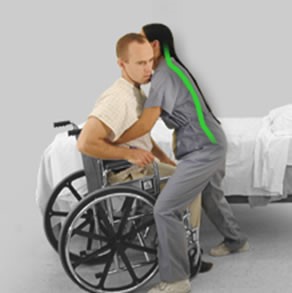
When helping the care recipient to sit in a chair, first think about the type of chair you should use. Consider the following points:
- Does the chair provide good support to the care recipient’s back? A straight back chair is often the best.
- Which chair gives the care recipient the most independence? One with arms is easier to get in and out of. Both a reclining chair and a low chair are difficult to get out of.
- What types of chairs are available? Varieties of chairs include living room chairs, kitchen/dining room chairs, and wheelchairs.
- Which chair is the safest? Chairs with arms, stable legs, loose parts, etc. are safest.
- Can the care recipient sit with the feet resting comfortably on the floor? If not a shorter chair may be more appropriate.
A wheelchair can provide good support and allow the care recipient freedom to move around the house. Always remember to lock the brakes on the wheelchair when moving to or from it. Make sure moving to or from the chair will be safe by considering where the leg extenders and wheels are located.
Assisting with a Standard Sit and Transfer
- Wash your hands.
- Explain to the care recipient what you are going to do.
- The care recipient should be in a sitting position with the transfer belt around the waist.
- Have the care recipient move forward on the bed or chair and place his/her hands on the chair arms or on the bed. If going to or from a wheelchair, make sure the brakes are locked.
- Place one of your knees between the care recipient’s and the other knee bracing their knee. You should be close to the chair or bed.
- Grasp the transfer belt and instruct the care recipient, on the count of three, to push down with hands, lean forward and stand. (If not using a transfer belt, grasp them under their arms, circling with your arms at their center of gravity.)
- Reverse the procedure when assisting the care recipient to sit.
- When sitting, have the care recipient feel for the bed or chair with the back of his/her legs and to reach back for the bed or chair arms.
- Make the care recipient comfortable.
- Wash your hands.
HOYER LIFT
The Hoyer lift is a mechanical lift used to move the care recipient. It might also be called a hydraulic lift or mechanized bath chair. Never use this lift to transport care recipients from one place to another. Guidelines for Using a Hoyer Lift Safety is a major issue when using the Hoyer lift, so consider these guidelines when using it:
- Check the lift to be sure it is safe to use—containing no loose parts, working properly, etc.
- Make sure the sling is safe with no rips, etc.
- Use the right size of sling for your care recipient.
- The sling should reach from the shoulders to the knees.
- Get as many wrinkles out of the sling as possible.
- When attaching the sling, the hooks should point away from the care recipient’s body.
- When positioning the lift in place, spread the base, or legs, for better support.
- Lock the wheels once lift is in place and before lifting the care recipient. Be sure to relock them when lowering the care recipient.
- Have the care recipient fold arms across the chest.
- Check the security of the sling as you raise the lift to be sure the connections have not come loose.
Use care when lowering the lift to protect the skin and the feet.